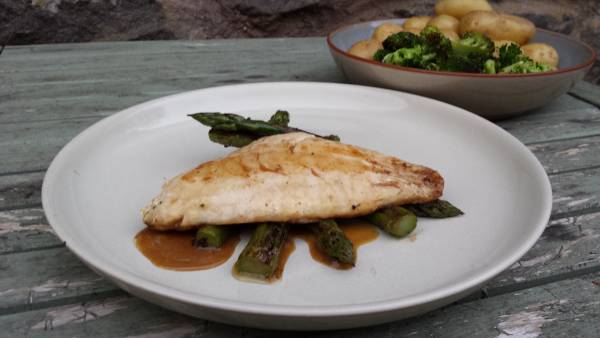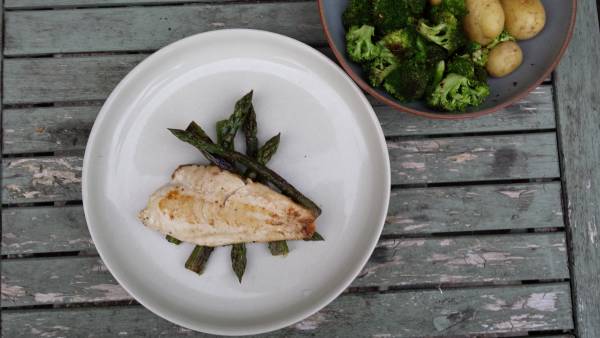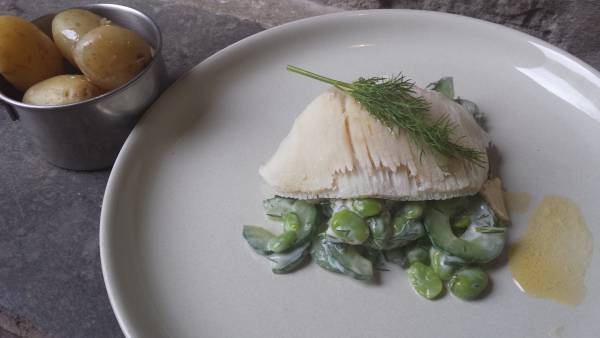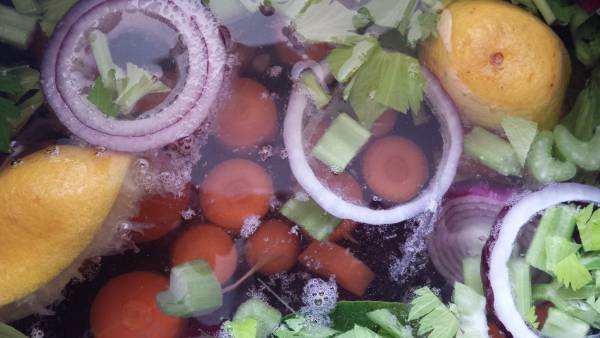“Simplicity is the ultimate sophistication.”
– Leonardo Da Vinci
As a Hardstyle kettlebell coach this is pretty much my training mantra, but it also applies to cooking, especially fish. There are only two ways I cook fish at home – frying and poaching – and I use the former far more often than the latter.
Fish is a much more delicate protein than meat, so it requires a delicate hand. Overcooked fish isn’t inedible, but a properly handled piece is much better.
Frying: Basic Method
Frying, often tautologically referred to as pan-frying (can you fry in anything else?), is my go-to method. Like I said about that recipe for brassicas and greens, if you are unsure what to do, do this and it will be great.
“You are probably already aware of the visual change as fish cooks. It loses the translucence and takes on a more opaque quality. Watching for this change is really all you need to know.”
The main key to frying a piece of fish well is observation. You are probably already aware of the visual change as fish cooks. It loses the translucence and takes on a more opaque quality. Watching for this change is really all you need to know. Aside from that, here’s the basic method:
- Put a pan on a high heat, with a little oil. As with meat, don’t cook it straight from the fridge. Season both sides with salt only (remember pepper will burn).
- Put the fish into the pan, skin side down. If it curls then rest a small ramekin or saucer on top to tease it down. Don’t prod it with a spatula as this will squeeze out some of the yummies and could cause the skin to detach, and don’t slash the skin.
- When the fish appears opaque to about halfway through, flip it over and cook the other side for one minute.
- Remove and rest before serving. Then a quick sauce can be made in the pan with a squeeze of lemon or a splash of wine and a knob of butter.
Why do I cook it mostly skin side down? First, because crispy skin is tasty and limp skin is gross. If I have paid for a fillet of fish, I’m sure going to eat all of it. The skin also acts as a barrier to protect the delicate flesh from the harsh heat of the pan and stops some of the lovely oils from seeping away, which are super good for us and tasty.

Poaching: Basic Method
This is a less used method in my house, but it’s still great. Poaching is better suited to larger fish or thicker portions of something like salmon, turbot, or large cod. It is important not to think of poaching as boiling. The temperature has to be a lot lower than that, at a gentle heat. As the fish cooks, the agitation of boiling will break up the flesh, leaving it scraggily.
So what we do instead of boiling is immerse the fish into a hot liquid medium, most often lightly flavored, and cook gently for about ten minutes. Notice I said liquid, because this can be done using multiple mediums:
- Milk: Often used for smoked fish. The milk can then be used to make something like a chowder.
- Water: Flavored with a few herbs, some vegetables, and a little vinegar. This light stock is called a court bouillon.
- Oil: This would be referred to as confit. In all cases the temperature is kept relatively low. +50°C (+122°F) is Heston Blumenthal’s recommendation, but that may be a tad under for a lot of people, and maintaining that exact temperature is nearly impossible in a domestic setting. So instead, you can use a more old-fashioned but good technique of cooking in residual heat, as I will explain in the poached fish recipe that follows.
Continue for Two Fish Dinner Recipes
Fried Fish With Lemon and Butter
I went to the shop to buy some fillets of bass for my wife and I came away with red snapper because it looked better. My point is, this recipe works for any small fillet of fish: bream, bass, snapper, cod, haddock, trout, and so on. Just buy what looks best. I served it with boiled new potatoes and that broccoli from last month.

Yield: Serves 2
Prep: None
Cook Time: 10 minutes
Ingredients:
- 2 x fish fillets
- 1 teaspoon oil for frying – use an oil with a high smoke point like peanut oil or coconut oil
- 1 lemon
- Knob of butter
- Salt
Method:
- Put a large pan on a high heat with a little oil. Season both sides of the fillets with a little salt.
- Lower the fillets into the pan one at a time, holding the thin end. Lower them in away from you, so you don’t get splashed with hot oil.
- Leave the fish alone, unless it curls in which case, as I mentioned above, rest a ramekin or saucer on top to encourage it down.
- When the flesh has turned opaque to about halfway through the fish, turn, add a knob of butter and cook for one more minute. Then remove from the pan and set somewhere to rest.
- Take the pan off the heat, squeeze in the lemon and add a big knob of butter. Stir it round to emulsify and lift any flavour and pour over your fish.
- Serve with boiled new potatoes and broccoli. And that is pure class.
Poached Skate Wing
Once again, I approached the fish counter planning to buy a couple of salmon fillets. Instead, I found myself attracted to some sustainably caught skate wings, so they came home with me. I had already planned a little salad to go with them. I wanted to use broad beans, as bitterness goes so well with salty. Add a little dill and cucumber – and done.

Prep: 20 minutes
Cook: 10 minutes
Ingredients:
For the Fish:
- 2x skate wings
- 100g broad beans (fava beans)
- Half of a cucumber
- Sprig fresh dill
- 1 tablespoon sour cream
For the Court Bouillon:
- 1 leek, sliced
- 2 carrots, sliced
- 1 bay leaf
- 1 lemon, halved and juiced
- 1 teaspoon peppercorns
- 1 tablespoon white wine vinegar

Court bouillon for poaching
Method:
- Bring a pan of salted water to the boil. Drop in the broad beans and bring back to the boil for one minute, then remove with a slotted spoon and refresh under cold running water.
- Add all of the court bouillon ingredients including the lemon halves to the pan. Bring back to boil, then switch off. Leave it to rest for 10 minutes while you shell the broad beans.
- Shell the broad beans, if you want, by pinching one end and squeezing out the bright green bean.
- Now bring the court bouillon back to the boil. Switch off the heat and when it stops bubbling lower in the fish, put the lid on, and leave it for 10 minutes.
- Halve the cucumber and scrape out the seeds using a teaspoon, then slice it. Mix the broad beans with the cucumber, sour cream, and dill.
- Put piles of salad onto plates and top with the cooked fish. Serve with boiled spuds.
You’ll Also Enjoy:






